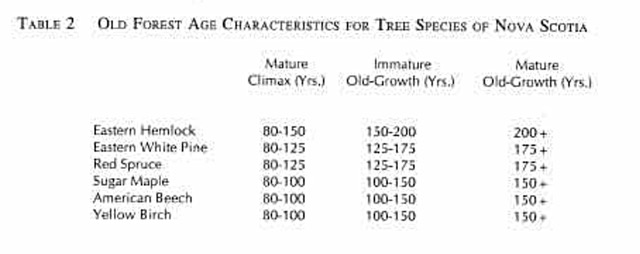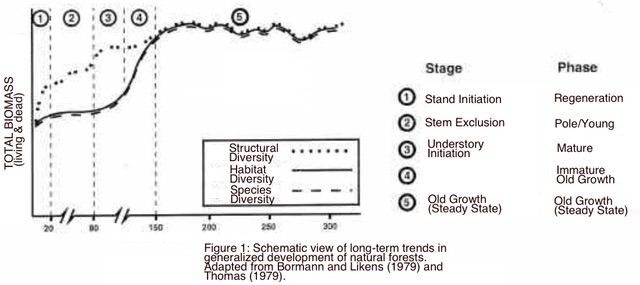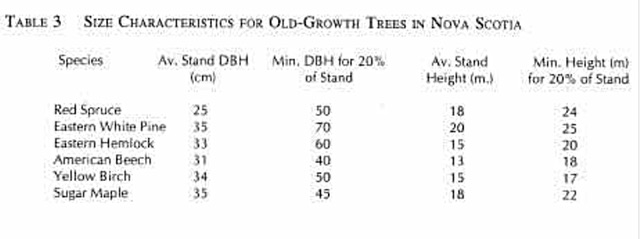Old forests of Nova Scotia: background & ecological characteristics
By Art Lynds and JOHN LeDuc. Nova Scotia Natural Resources Parks and Recreation Division Occasional Papers No. 1, September 1995, 18pp
Thanks to John LeDuc for scanning and forwarding a PDF of this paper
The following excerpts should be especially helpful to those seeking to answer the question “What is Old Growth Forest in Nova Scotia”. I have added some bolding to make it easier to read on the web, also modified some lettering on the figure so it is more readily discernible in this format.
———————
4.1 Natural Forest Development
The typical developmental sequence of a latest stand following a catastrophic disturbance can be described as four stages: stand initiation, stern exclusion, understory initiation and old-growth
“Stand Initiation”
Fallowing a major disturbance such as windthrow. fire, or harvesting, trees [as well as shrubs and herbaceous species} quickly invade the disturbed site. New growth is accomplished by several regenerative strategies ~ external seed sources, buried seed, sprouts, suckers, and/or advanced regeneration. The majority of future mature stems have their beginnings in this Initial stage – very few new stems are added until the old‐growth or steady state stage is reached.
This initial stage can continue for as long as 20 years due to a variety of factors including forest type, timing and intensity of disturbance, size of disturbance. regeneration strategy of invading species and their silvic characteristics to name but a few.
”Stem exclusion”
Once the disturbed site has been fully occupied by young tree stems, that is to the maximum foliage points competition for growing space, light, nutrients, and water, intensifies to the point where (i) second-wave new stems cannot become established and (ii) severely-stressed existing individual stems cannot maintain themselves and therefore die off. Other associated plant forms are also negatively affected.
This is the stem exclusion stage. Even minor disturbances at this stage do not generally allow for new stems to become established, as the gap is usually filled by the canopies of existing trees.
“Understory Initiation“
The understory initiation stage has its beginning with the maturing of the forest stand. As the overstory gets older and taller, individual trees or clumps of trees (depending on species and environmental factors) fall out at the upper canopy creating a void all the way to ground level. This allows direct light and/or light flecks to reach the ground surface.
With more light penetration and lack of competition, young moderately shade tolerant to very shade tolerant tree seedlings, shrubs, and herbaceous plants can become established under the existing canopy.
As forests grow still older, 3 higher percentage of trees within the stand, especially those that are stressed, tend to be more susceptible to dlsturbance. This, of course, is heavily dependent upon species and environmental site conditions.
“Old growth”
As the understory slowly breaks up, the established regeneration underneath is released into the upper canopy and becomes codominant with the dominant relict trees, This is the initiation of the old‐growth stage where multi‐layering starts to become a major feature.
The nature of oId-growth forest varies regionally. Variations within the different stages are used by different forest ecosystems to Teach and maintain their steady state. For example, the northern deciduous forest of eastern North America uses the reciprocal replacement-gap phase strategy while the boreal balsam fir forest is a mosaic of waves and patches. Figure 1 graphically depicts the development of natural forests.
4.2 OLD FOREST CLASSES
ln Nova Scotla, four classes at old forests can be identified: mature climax, immature old-gowth, old-growth and other stable forests Because of site variability and the fact that forest development is a gradient process, the following old forest classes are not definitive.
The mature climax forest is a pivotal point in forest succession. This phase of greatest bole biomass and little diversity changes into a phase of slight decrease in bole biomass and a significant increase in structural diversity. This in turn promotes the development of microhabitats and species diversity. Depending on species. this phase occurs between 30 and 125 years of age. Mature climax forests are the potential old‐growth forests of the furture.
Immature old-growth forests are very near to being old-growth forests, that is, they only lack in one or more of the characteristics of mature old‐growth. These forests can be expected to display all the old‐growth forests characteristics in the near future. The immature old-growth is in the initial stages of canopy breakup with a corresponding accumulation of large coarse woody debris and stand layering. Again, depending on species, this phase ranges between 100 and 200 years of age.
The true or mature old-growth phase exhibits very distinctive compositional and structural attributes compared to the other phases. Very large scattered trees, multi-layering in the understory, a massive jumble of coarse woody debris on the ground, and usually a very distinctive array at lower plant and animal species are in contrast to even-aged, less diversified younger forests. In Nova Scotia, no systematic inventory of old-growth forest dependent species {in particular fungi, lichens, micro‐invertebrates etc.) has been undertaken to date. Ages for representative old-growth forests generally begin at 150 years of age.
The fourth class of old forests can be described simply as ‘other stable forests’. Because of the frequency at natural disturbances (eg. fire, flooding, hurricanes. colluvial activity, pathogens, etc.) and certain topoedaphic circumstances, many forest ecosystems never reach the steady state, climax stage. For example. red maple, a relatively short-lived species of 150 years, seems to be able to maintain dominance over sites where soil moisture conditions are extreme (such as seasonally flooded river lens in the southwestern part of Nova Scotia), or sites that the other tree species cannot tolerate. Other non-climax species that may form old stable forest include red oak, black spruce, red pine, highland balsam fir, and coastal white spruce.
5.0 ECOLOGICAL CHARACTERISTICS OF MATURE CLIMAX to OLD-GROWTH FORESTS IN NOVA SCOTIA
The following ecological characteristics of three old forest classes (mature climax, immature old-growth, mature old-growth) are presented to assist in understanding and identifying old forest ecosystems or stands. At this time, due to a lack of information, it is not possible to describe the ecological characteristic “other stable forest”, the fourth class of old forest identified above. It is not necessary for a forest to reflect all the following characteristics. Due to the wide variability in nature, these characteristics should not be used as definitive criteria but as general guidelines.
5.1 SPECIES COMPOSITION
Older forests differ significantly in species composition from young forests. Plant communities, and consequently animal communities, pass from a short lived early successional system in young forests to a more diversified, stable. climax system in older forests.
Each stage in the succession is characterized by its species composition. In mature climax to old‐growth forests, the majority of tree spaces are generally long-lived. They are also tolerant of and able to reproduce in the shaded microclimate cerated by the overstory canopy. The. Following list represents the near-climax to climax native tree species found in Nova Scotia.
Acer saccharum – Sugar Maple
Betula allegheniensis – Yellow Birch
Fagus grandifolia – American Beech
Tsuga canadensis – Eastern Hemlock
Pinus strobus – Eastern White Pine
Picea rubens – Red Spruce
5.2 AGE
Table 2 presents age characteristics for climax tree species In Now Scotia at mature climax, immature old-growth and mature old-growth stages of development.

5.3 STRUCTURE
Structurally. older forests offer a striking contrast to younger natural and lntensively managed forests. Visually, the larger diameters and heights of the older trees and the complex layering and species composition catch one’s eyes immediately. Table 3 represents size characteristics for trees at old‐growth stage in Nova Scotia.
Table 4 provides a general framework for distinguishing mature climax, immature old-growth and mature old-growth with respect to their structural attributes.



